
HOSHINOYA Tokyo opened on July 20, 2016, in Otemachi, Tokyo, as the fifth property of the HOSHINOYA brand, which offers an overwhelming sense of the extraordinary through unique themes. With the concept of a "Tower of Ryokan," this vertical space, spanning two underground and 17 above-ground floors, comprises a tatami-floored entrance, guest rooms that blend traditional Japanese design with modern comfort, the OCHANOMA Lounge on each floor, and a hot spring bath on the top floor. The property offers seasonal decorations, activities that convey the culture of Edo and Japan, and the characteristic hospitality of a traditional ryokan.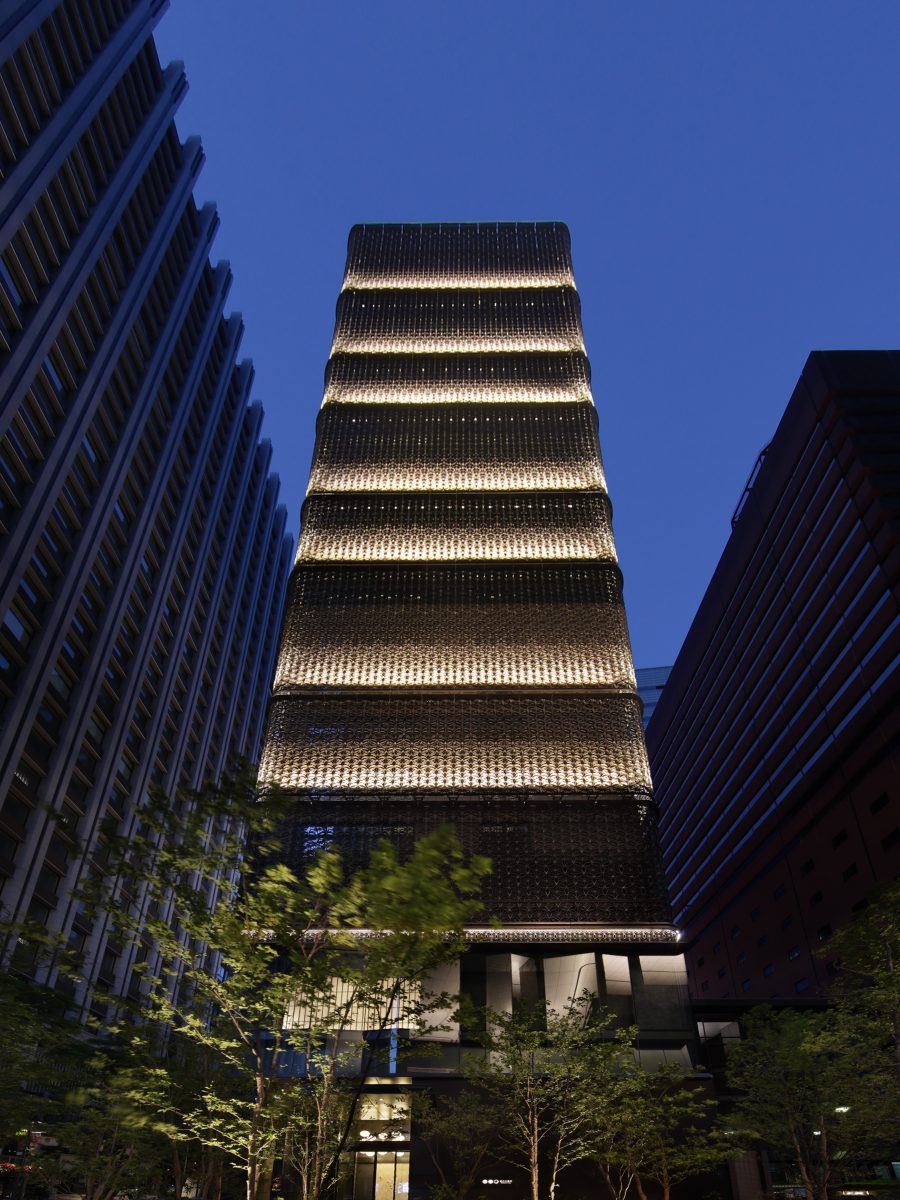 Concept: Tower of Ryokan
Concept: Tower of Ryokan
Historically, the Japanese ryokan has been an extremely private space designed for visitors to relax deeply and truly feel at home. Unlike the concept of a "guest" in Western accommodations, a ryokan encourages visitors, upon leaving their footwear at the entrance, to spend their time barefoot and at ease, much like the residents of the household. HOSHINOYA Tokyo honors this tradition: guests remove their shoes at the entrance, and no slippers are provided, allowing for direct contact with the scent and the texture of the tatami mats. Past the small garden at the entrance and through the large cypress door, the seasonal display on the bench, which reflects the Japanese calendar, comes into view. Experiencing the changing seasons in every detail is a unique aspect of the Japanese ryokan. The interior is almost entirely connected by tatami flooring. Guest rooms feature natural materials like tatami, Japanese paper (washi), and bamboo closets. The building's exterior is covered in a delicately patterned lattice, designed with a traditional Japanese motif. While blending into the office district as a sleek, dark building, a closer look reveals the refined Japanese design, clearly identifying the property as a ryokan.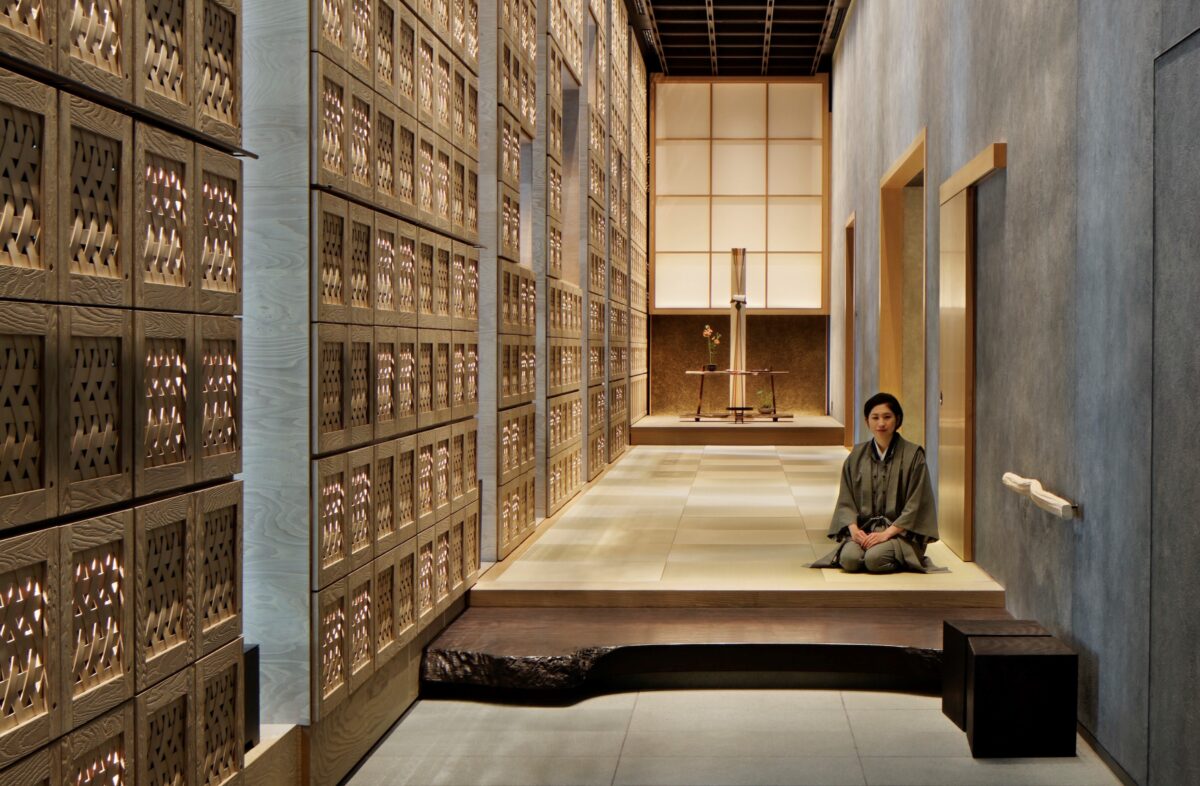 A specially designed kimono-style room wear, created by Jotaro Saito, is provided in the guest rooms. It can be used not only for moving around the ryokan but also as street wear for walks or quick errands in the Otemachi, Imperial Palace, or Kanda areas. Each of the 14 guest room floors is designed to evoke a small, self-contained ryokan, featuring six guest rooms and the shared OCHANOMA Lounge. This stacking of individual ryokans forms the overall concept of the "Tower of Ryokan." As each floor is a semi-private space accessible only to its registered guests, a deeply relaxed atmosphere is fostered.
A specially designed kimono-style room wear, created by Jotaro Saito, is provided in the guest rooms. It can be used not only for moving around the ryokan but also as street wear for walks or quick errands in the Otemachi, Imperial Palace, or Kanda areas. Each of the 14 guest room floors is designed to evoke a small, self-contained ryokan, featuring six guest rooms and the shared OCHANOMA Lounge. This stacking of individual ryokans forms the overall concept of the "Tower of Ryokan." As each floor is a semi-private space accessible only to its registered guests, a deeply relaxed atmosphere is fostered.
Traditional Architecture and Modern Tatami Guest Rooms
The most spacious room, the Kiku (Executive Triple), accommodates up to 3 guests and offers approximately 80 sqm. This corner room, located at the end of each floor, includes a dining table and a walk-in closet, making it highly recommended for longer stays. 
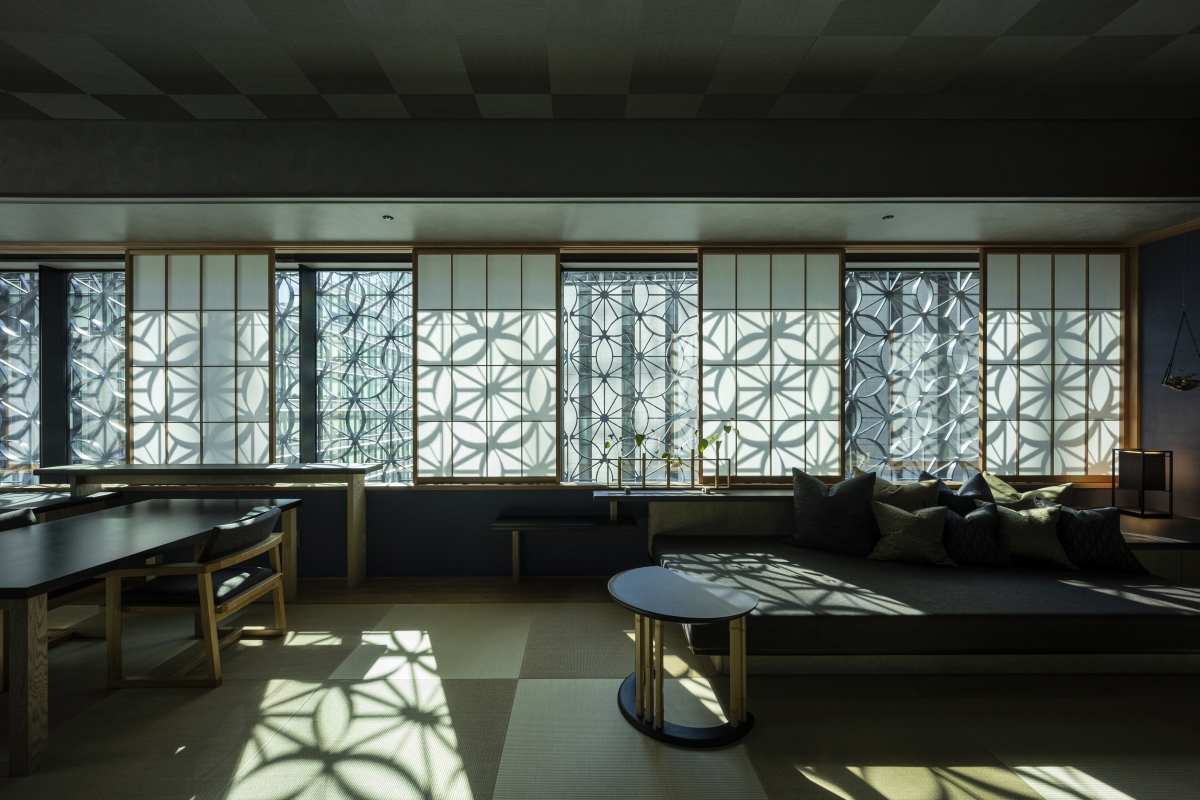
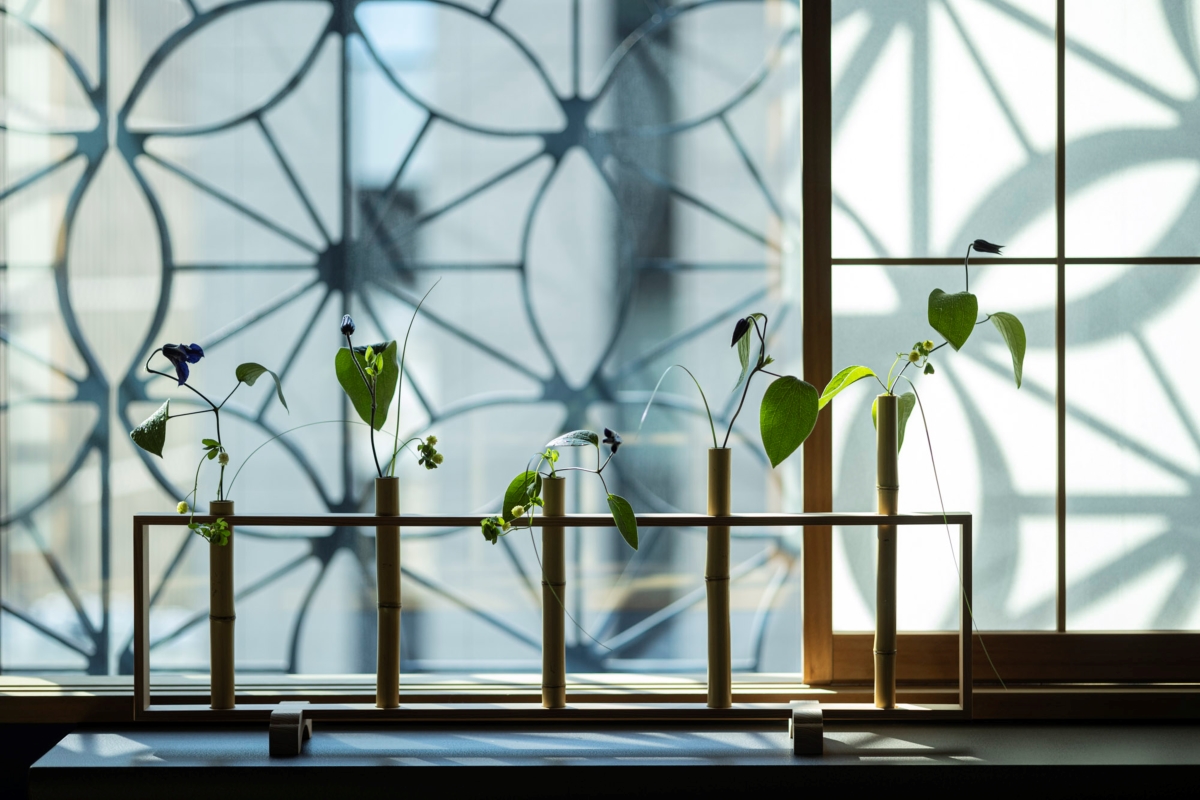 The Yuri (Deluxe King) and Sakura (Deluxe Twin) rooms, approximately 45 sqm and accommodating up to 2 guests, are traditional Japanese-style rooms featuring furnishings made from bamboo and chestnut, and thick paper screens. Guests can fully relax on the low-slung tatami sofa and the original bedding. These rooms are available in two types: King (Yuri) and Twin (Sakura).
The Yuri (Deluxe King) and Sakura (Deluxe Twin) rooms, approximately 45 sqm and accommodating up to 2 guests, are traditional Japanese-style rooms featuring furnishings made from bamboo and chestnut, and thick paper screens. Guests can fully relax on the low-slung tatami sofa and the original bedding. These rooms are available in two types: King (Yuri) and Twin (Sakura).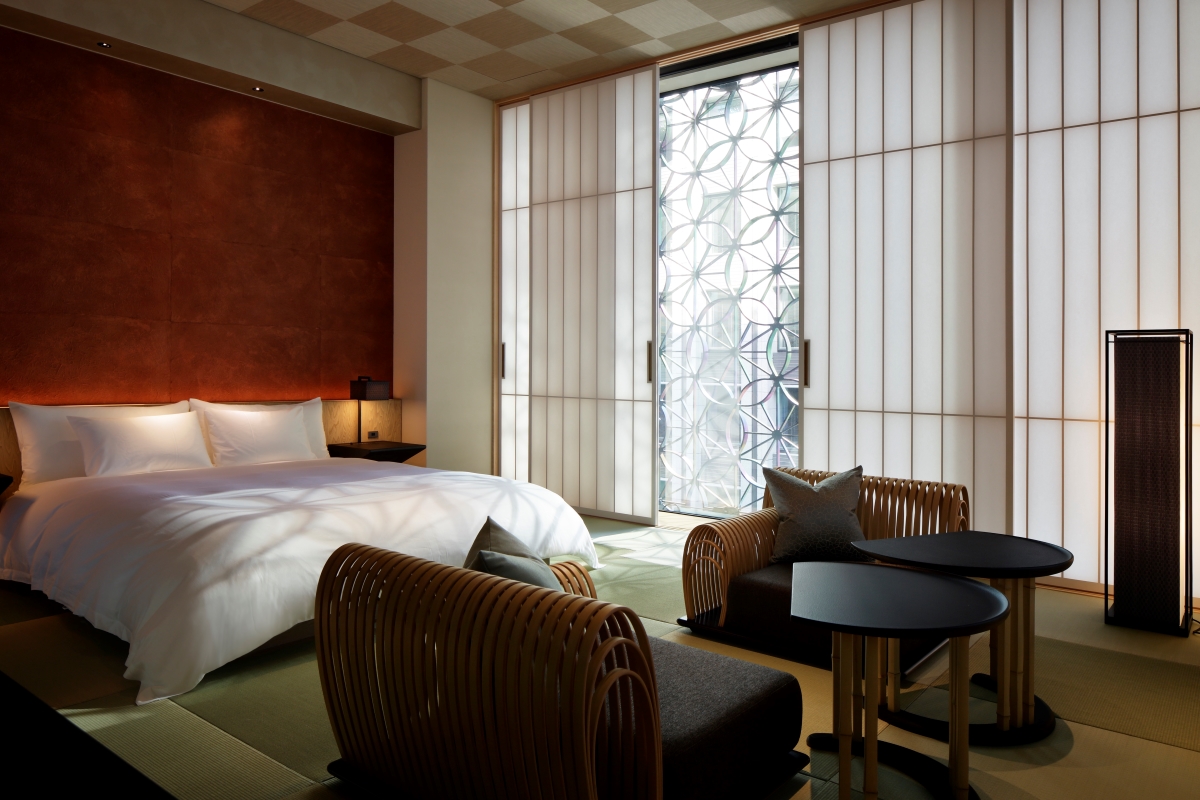
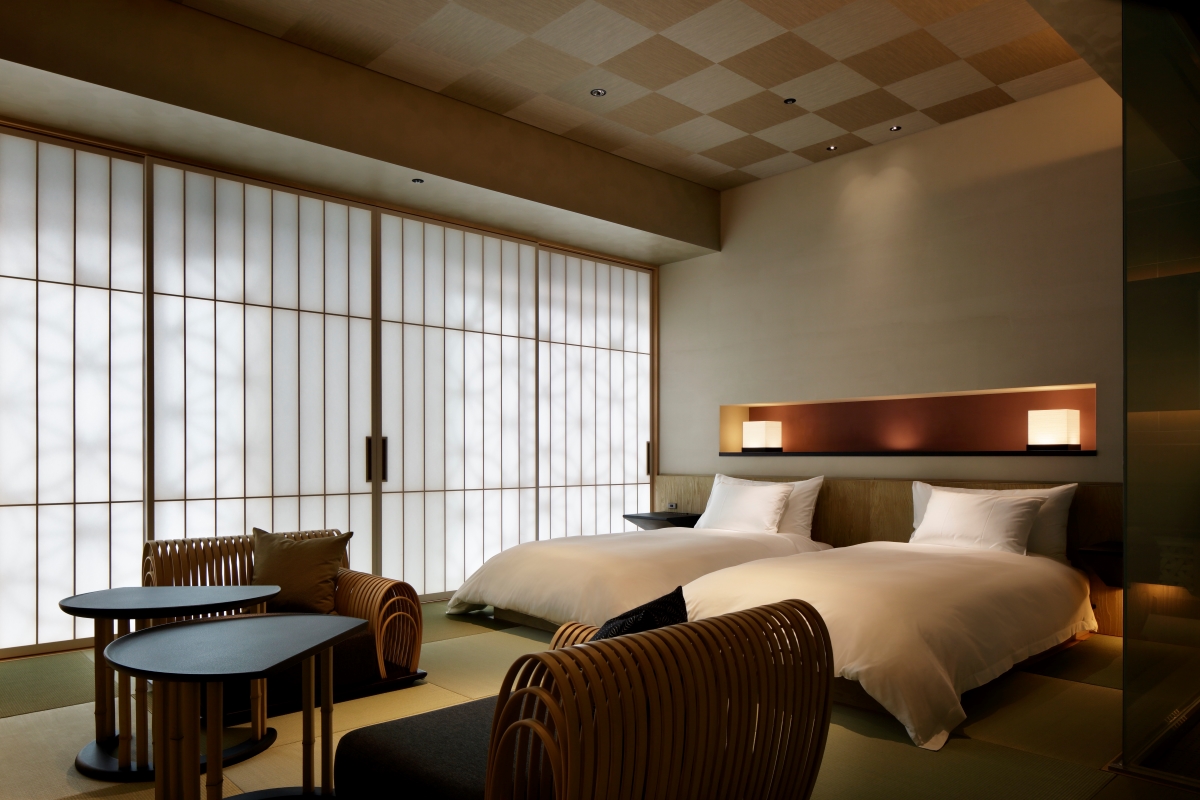
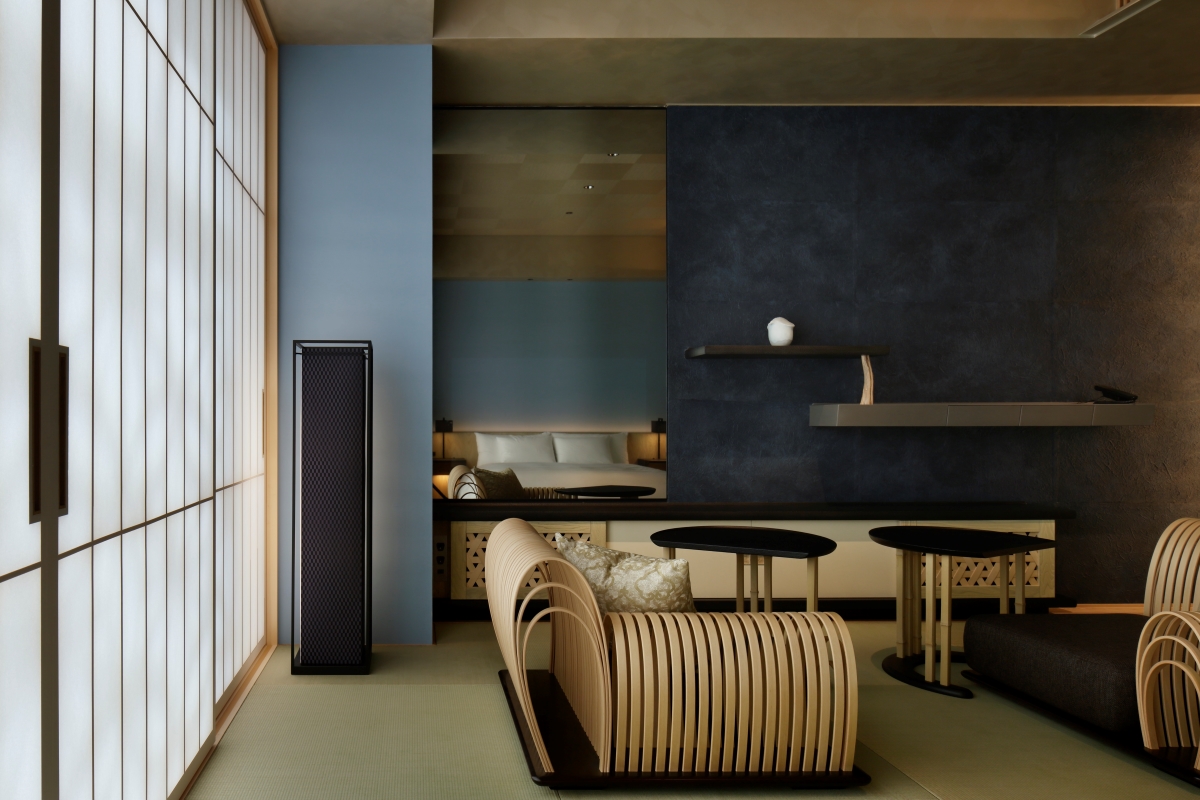
OCHANOMA Lounge
The OCHANOMA Lounge is exclusively for guests staying on that floor and is freely accessible from the connecting guest rooms. This semi-private space is available 24 hours a day. The shelves display curated works by artisans active across Japan, selected by HOSHINOYA Tokyo staff. This communal living room-style area provides a relaxed setting for guests to sit anywhere they choose, enjoying seasonal snacks and beverages. It also serves as an intimate space for travelers staying on the same floor to gather and converse.
The Hot Spring & Spa Treatment
The Hot Spring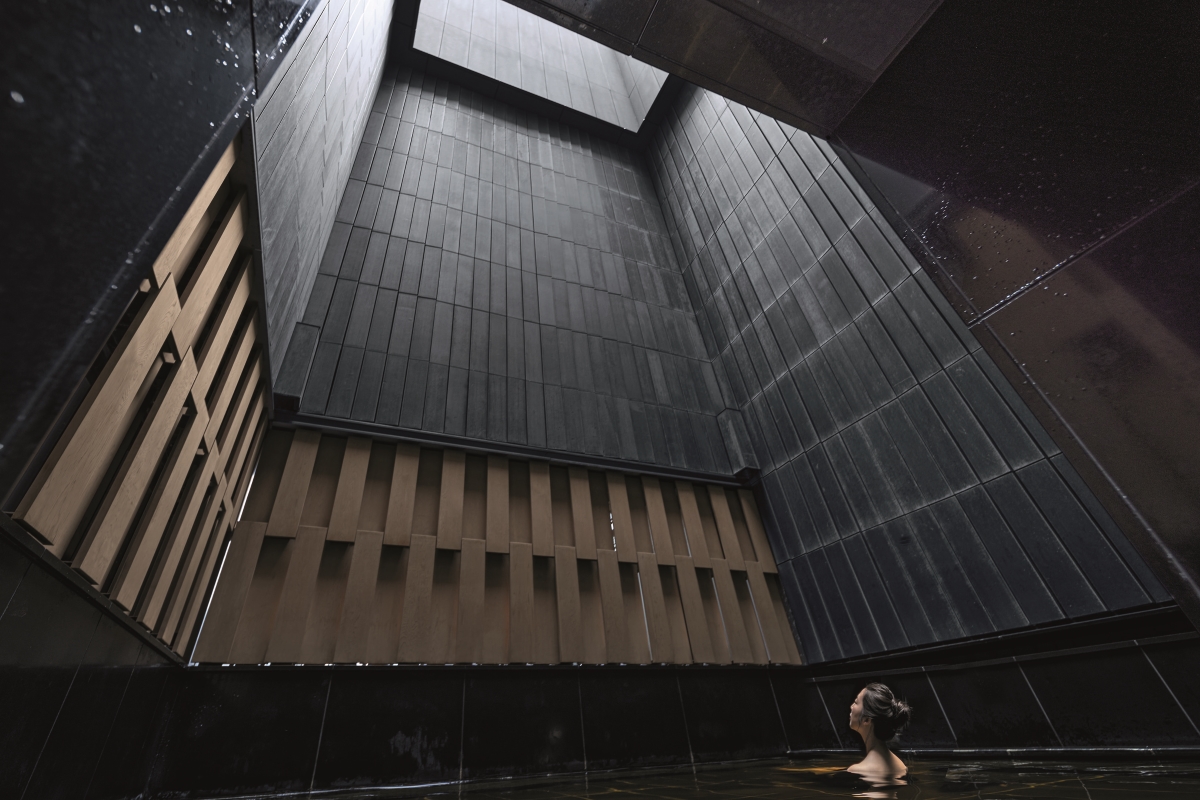
On the 17th floor, the top floor, there is an indoor bath and an open-air bath fed by the natural Otemachi Hot Spring, which flows from 1,500 meters underground. Guests can relax and soak in the soothing waters while being right in the city center. The open-air bath allows guests to feel the seasons through the Tokyo wind and sounds passing through the lattice.
Opening hours: 3:00 pm – 11:30 am the following day
Otemachi Hot Spring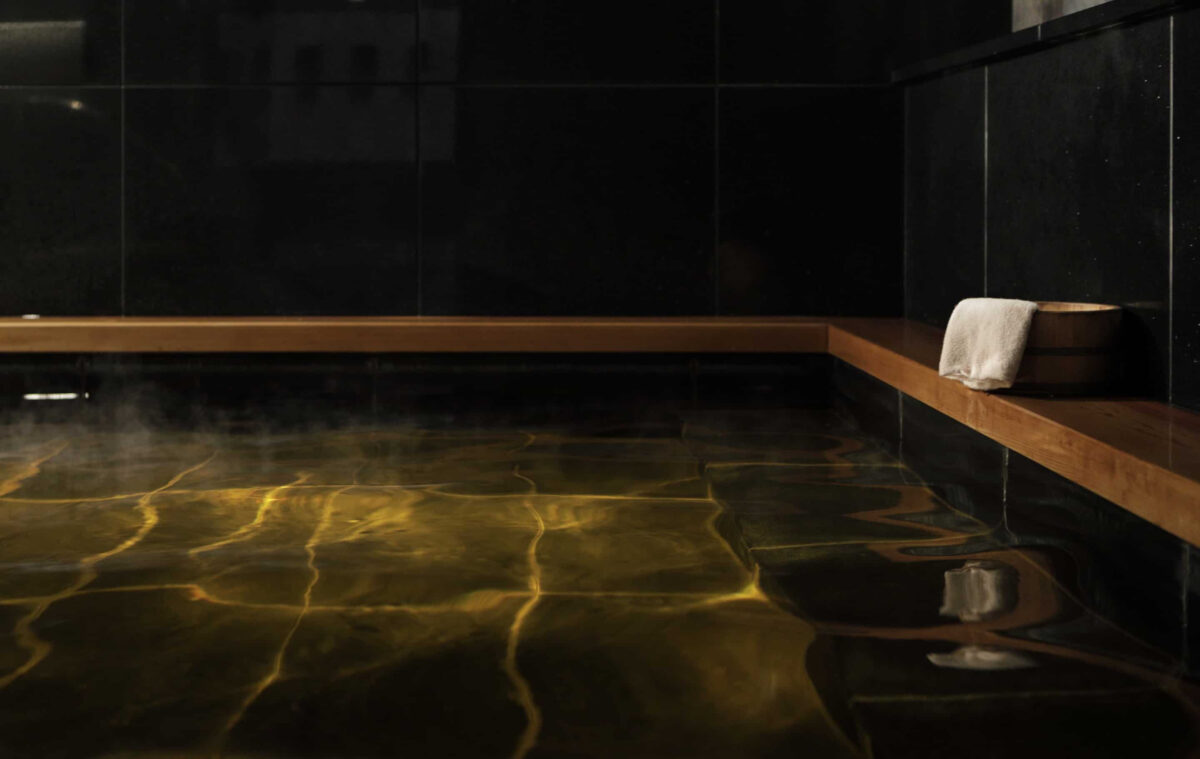
The water quality of the Otemachi Hot Spring is a strong sodium chloride spring containing iodine. This highly saline hot spring is rich in minerals from seawater and seaweed that were trapped deep underground. The slightly black, viscous water is known for its high moisturizing and heat-retaining properties, said to be effective for poor circulation and fatigue recovery.
Spa Treatment A variety of programs are available, starting with all-hand oil treatments utilizing a comfortable rhythm, and including facial treatments using cosmetics that contain traditional Japanese and Chinese botanicals. Prior to the treatment, warming the body by soaking in the hot spring on the same floor helps to relieve physical and mental tension, leading to deeper relaxation.
A variety of programs are available, starting with all-hand oil treatments utilizing a comfortable rhythm, and including facial treatments using cosmetics that contain traditional Japanese and Chinese botanicals. Prior to the treatment, warming the body by soaking in the hot spring on the same floor helps to relieve physical and mental tension, leading to deeper relaxation.
Price: From 28,050 JPY for 90 minutes (inclusive of tax and service charge).
Menu: Body Treatments, Facial Treatments.
Sample Menu: Body Treatment "Shiki" (Four Seasons)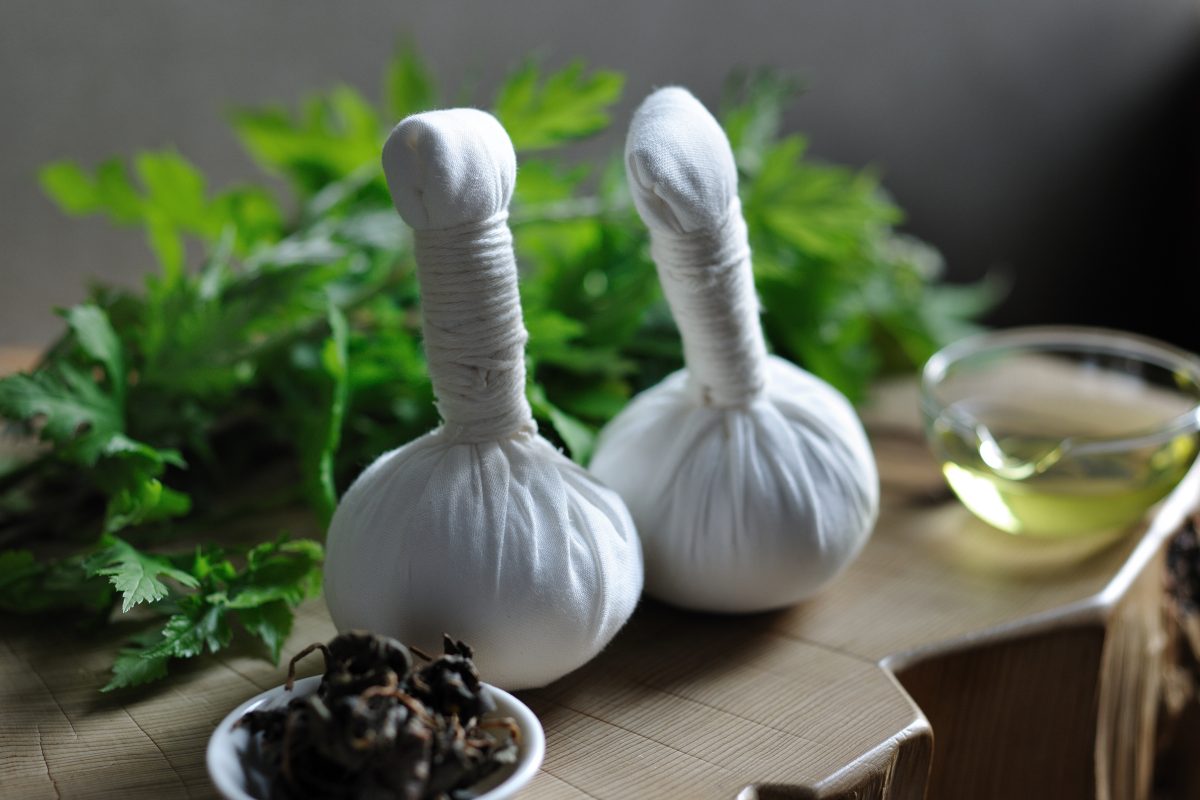 This is a full-body treatment using HOSHINOYA's original herbal pouches. The pouches, steamed with seasonal plants, are used to gently warm the back, legs, head, upper chest, and arms, enveloping the whole body in a slow, soothing touch.
This is a full-body treatment using HOSHINOYA's original herbal pouches. The pouches, steamed with seasonal plants, are used to gently warm the back, legs, head, upper chest, and arms, enveloping the whole body in a slow, soothing touch.
Price: 33,880 JPY for 90 minutes (tax and service charge included)
Dinner at the Main Dining: Lost Flavors of Japanese Home Recipes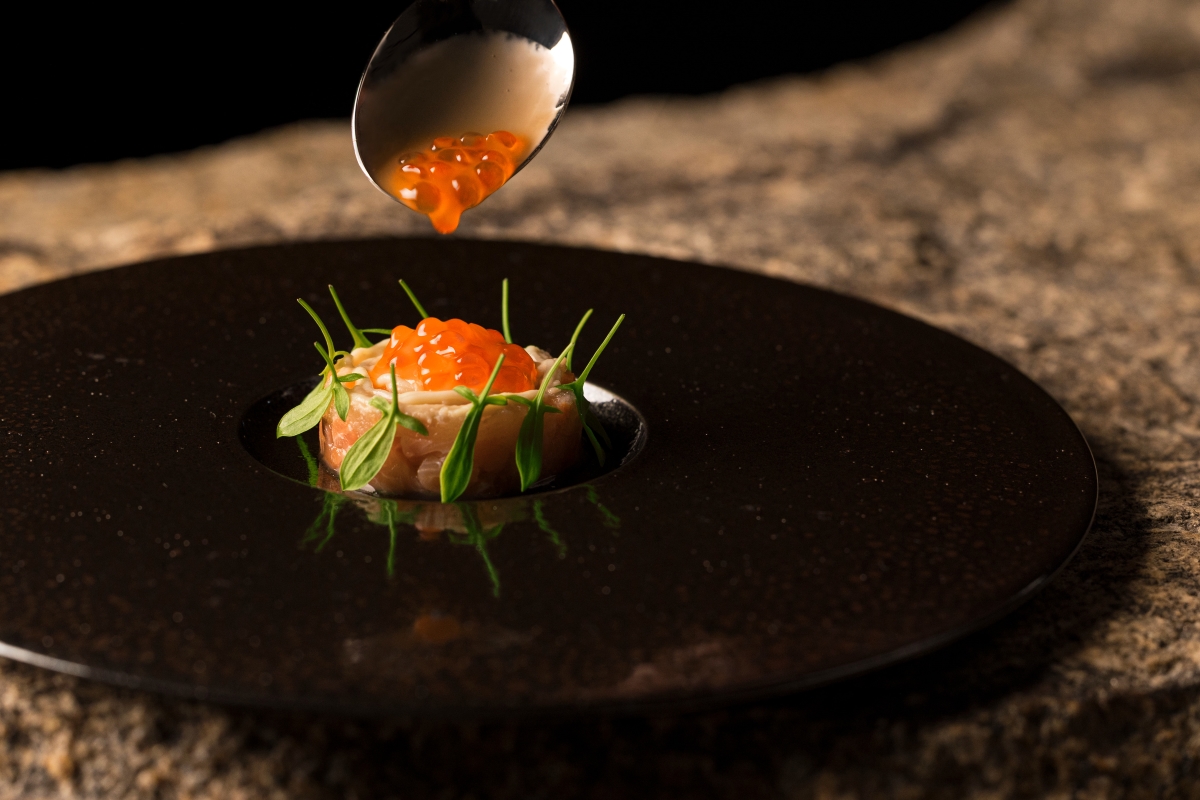
The HOSHINOYA Tokyo Main Dining launched a new dinner course on September 16, 2025, based on the concept of "Lost Flavors of Japanese Home Recipes." Chef Ryosuke Oka shines a light on "the taste of Japanese home cooking" that has quietly disappeared from modern tables due to the changing times.
Price: 33,880 JPY per person (tax and service charge included).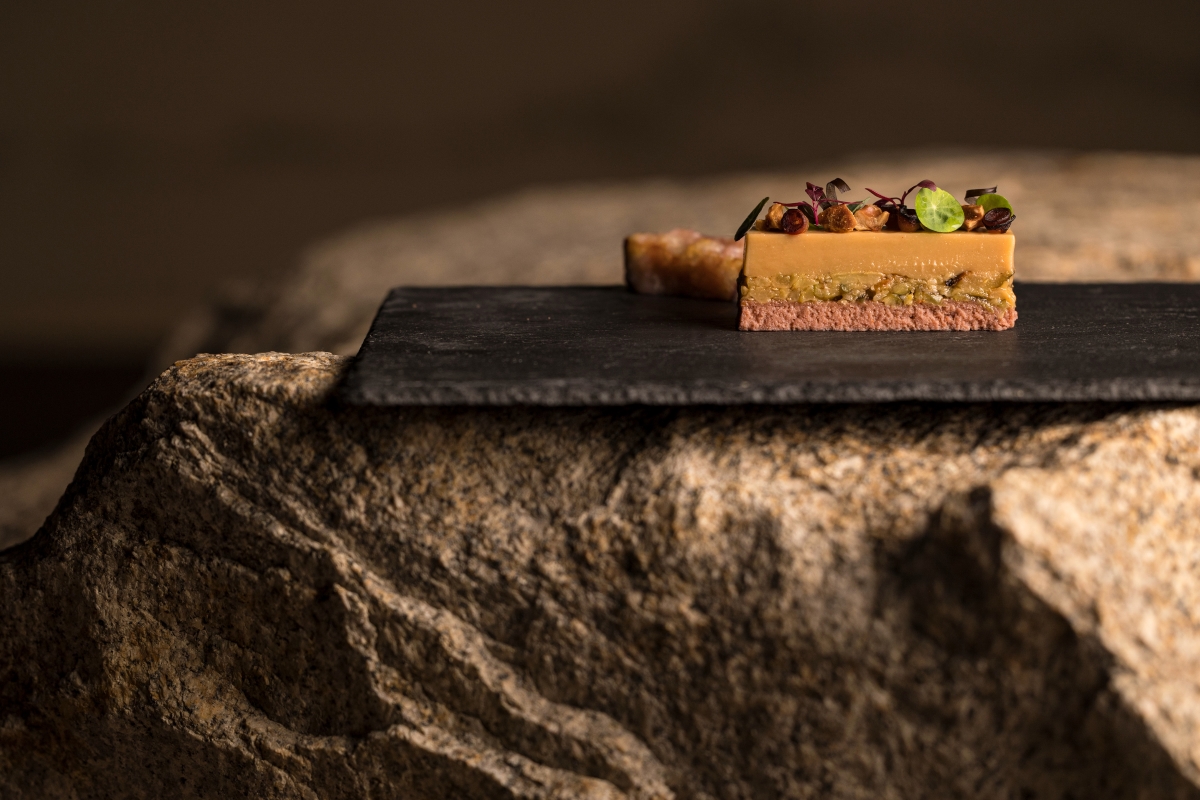
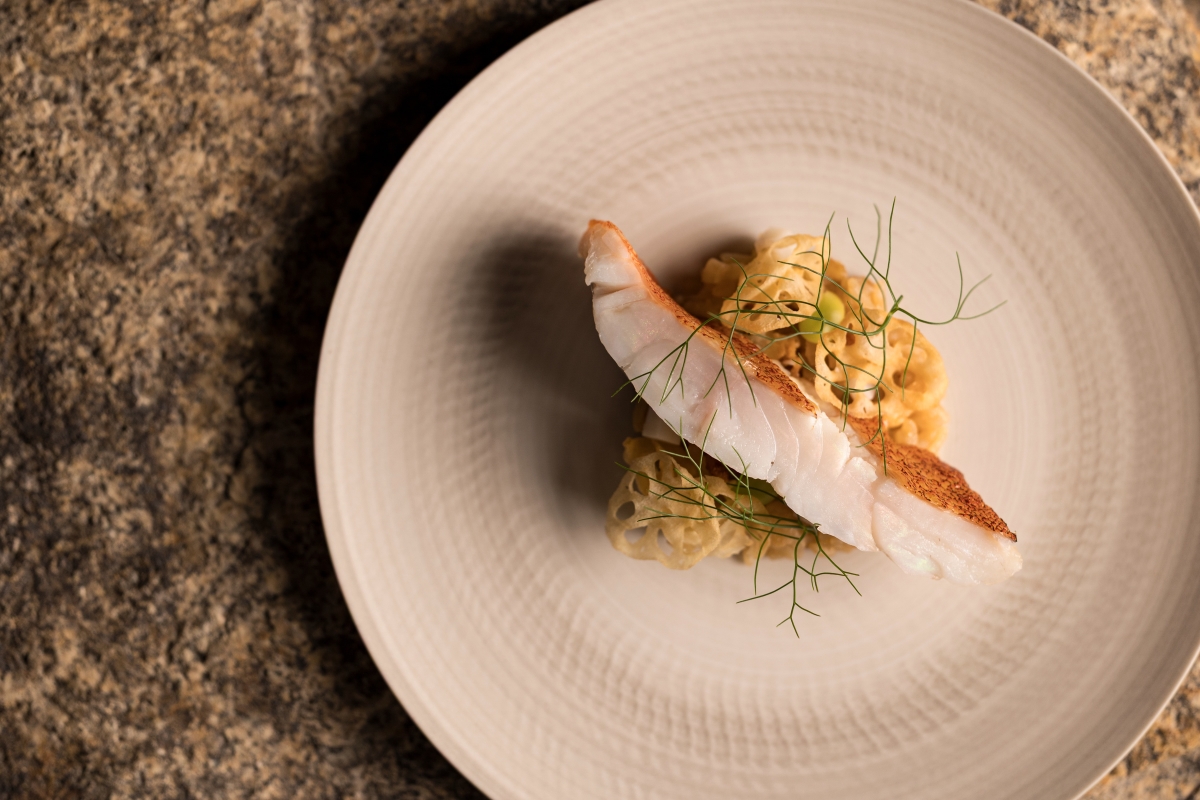 Profile: Ryosuke Oka, Executive Chef of HOSHINOYA Tokyo
Profile: Ryosuke Oka, Executive Chef of HOSHINOYA Tokyo
Born in 1985 in Shiga Prefecture, Ryosuke Oka honed his skills in French cuisine at establishments such as Kobe Kitano Hotel and Pierre Gagnaire. He assumed the position of Executive Chef at HOSHINOYA Tokyo on May 1, 2023. His culinary philosophy is "to pursue cuisine that can only be created in that specific region."
Dinner: Sushi Otemon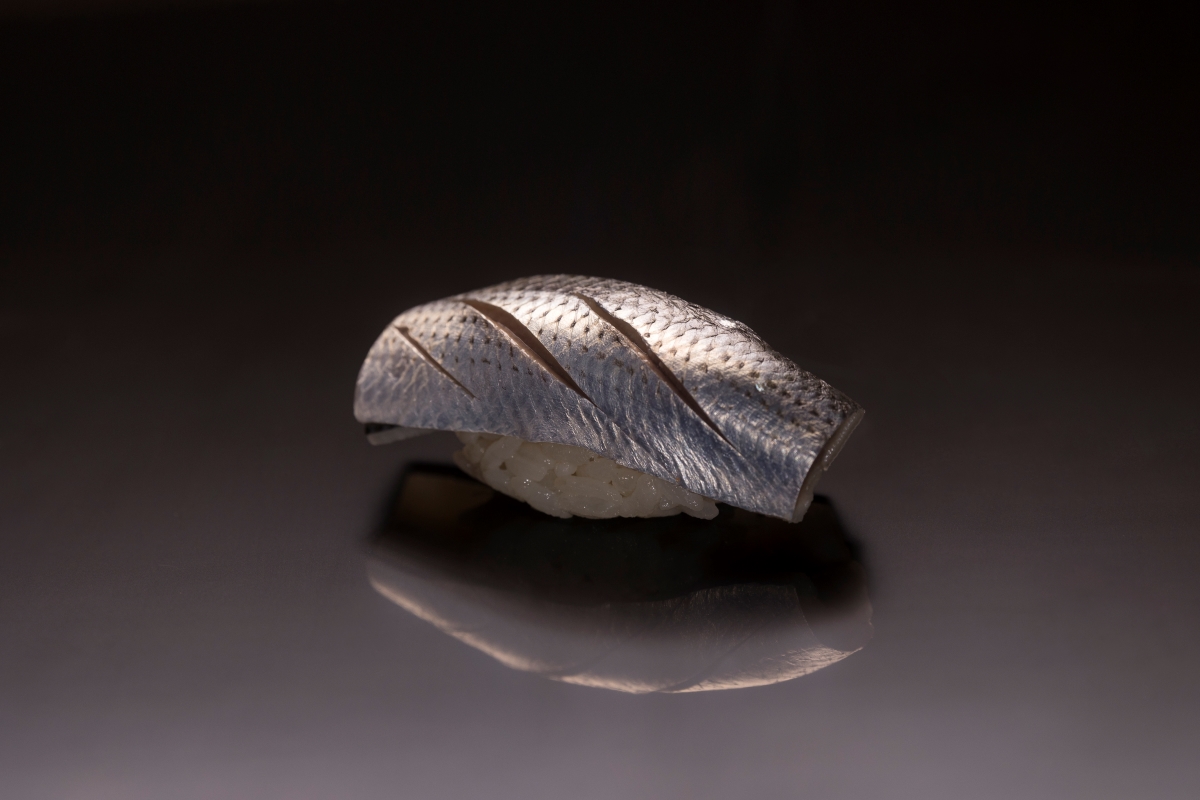
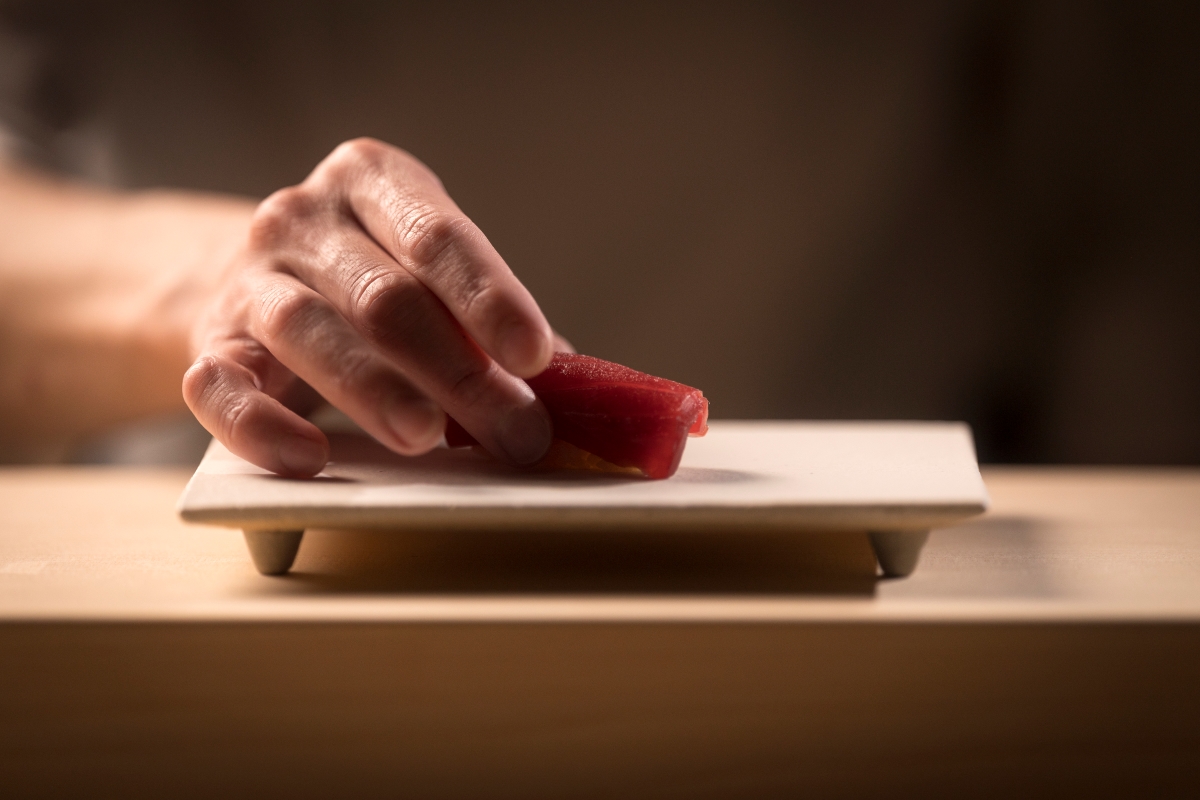
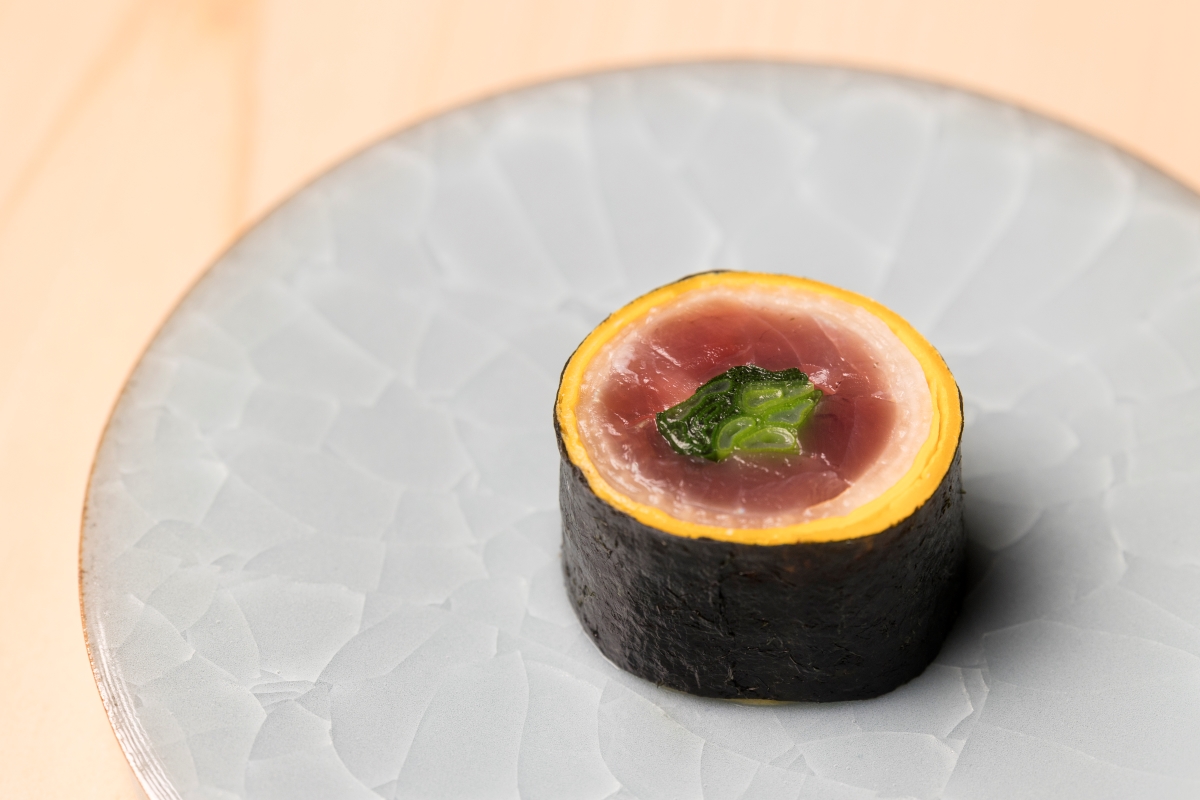
Sushi Otemon opened in March 2025 in a corner of the main dining area on the B1 floor, featuring an 8-seat counter. The concept is "Rooted in Edomae, Crafted by Ryokan." It primarily utilizes traditional Edomae sushi techniques while also incorporating sushi culture from various regions across Japan. Staying guests are welcome to visit straight from the bath, barefoot and in their room wear.
Price: 36,300 JPY per person (tax and service charge included)
B1 Floor Design (Subterranean Dining Floor)
The subterranean dining floor is a testament to HOSHINOYA Tokyo's concept of the "Tower of Ryokan." Entering the space, guests encounter an artistic expression of the earth itself, rendered in rich, textured plasterwork and magnificent natural stone. Beyond this dramatic foyer, the floor transitions to a peaceful area featuring six secluded tatami rooms and four elegant table seats. The atmosphere is one of exclusive ryokan tranquility, allowing for sophisticated, yet completely relaxed, dining in the comfort of one's room wear.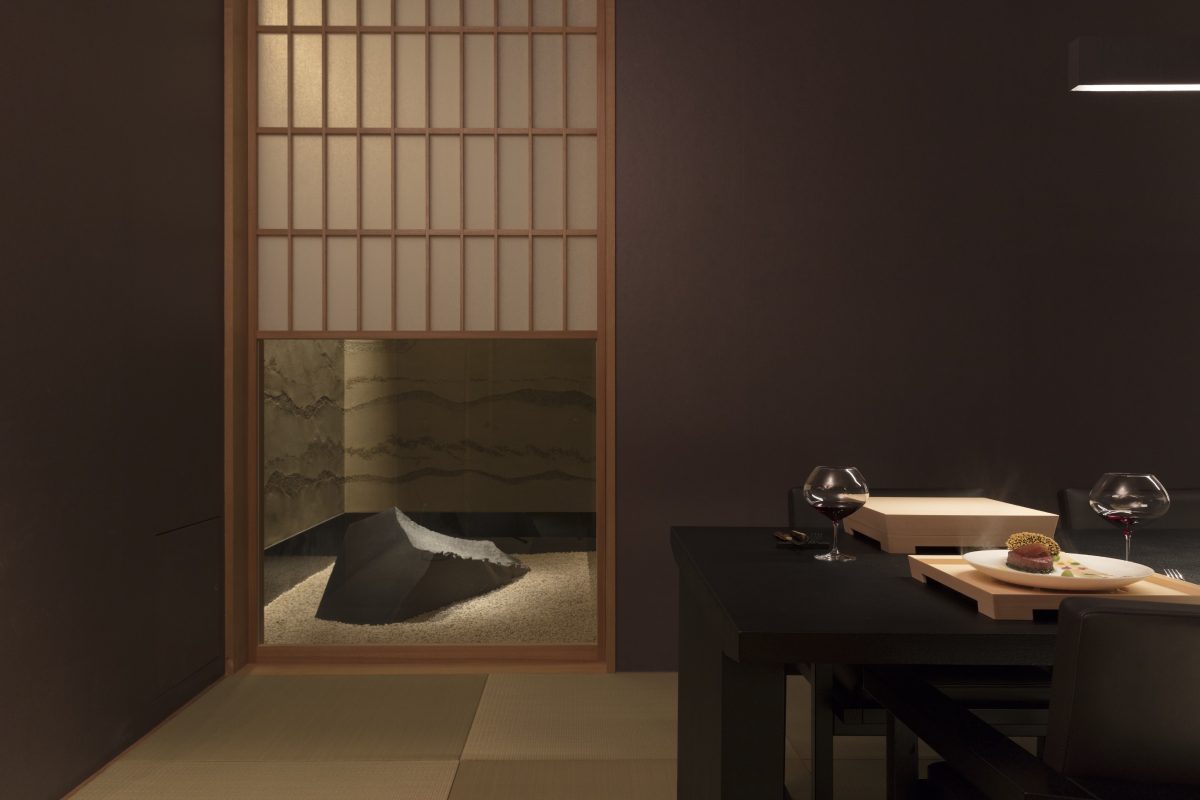
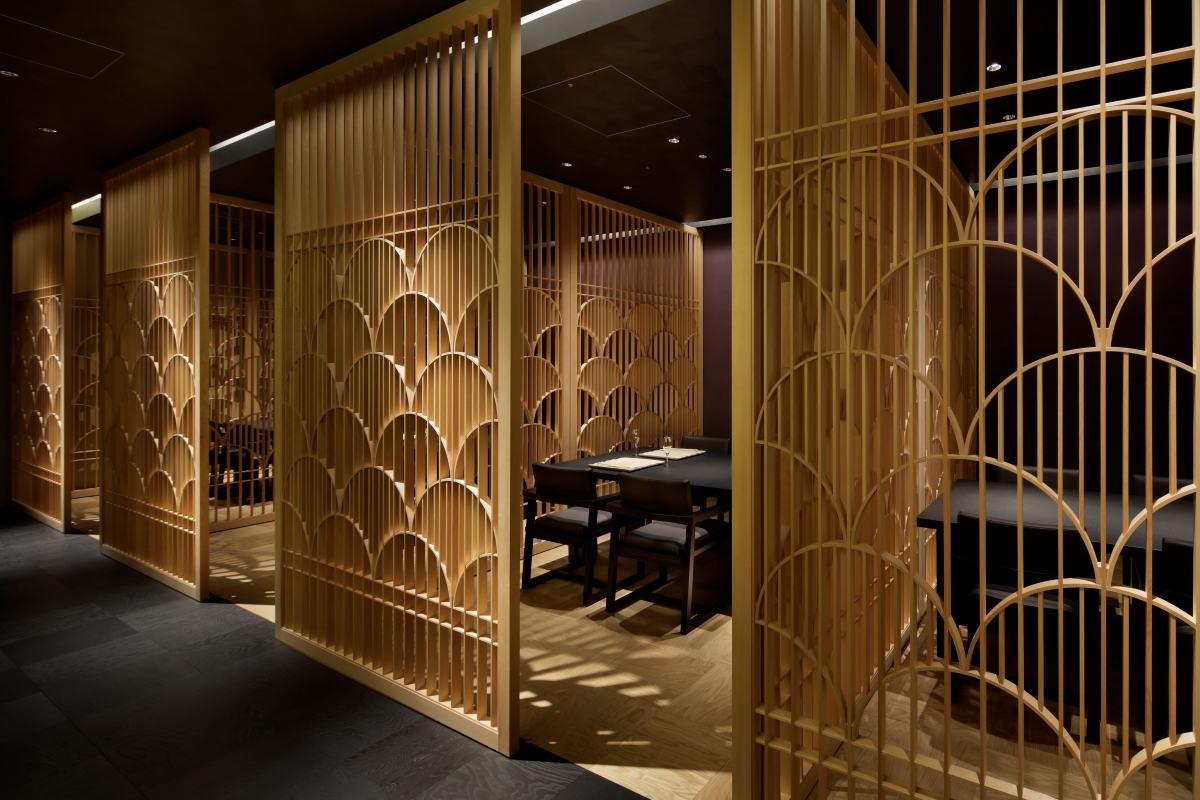
Breakfast & In-Room Dining
Breakfast can be chosen according to the preferred morning style.
Dining Breakfast: Holistic Ryokan Breakfast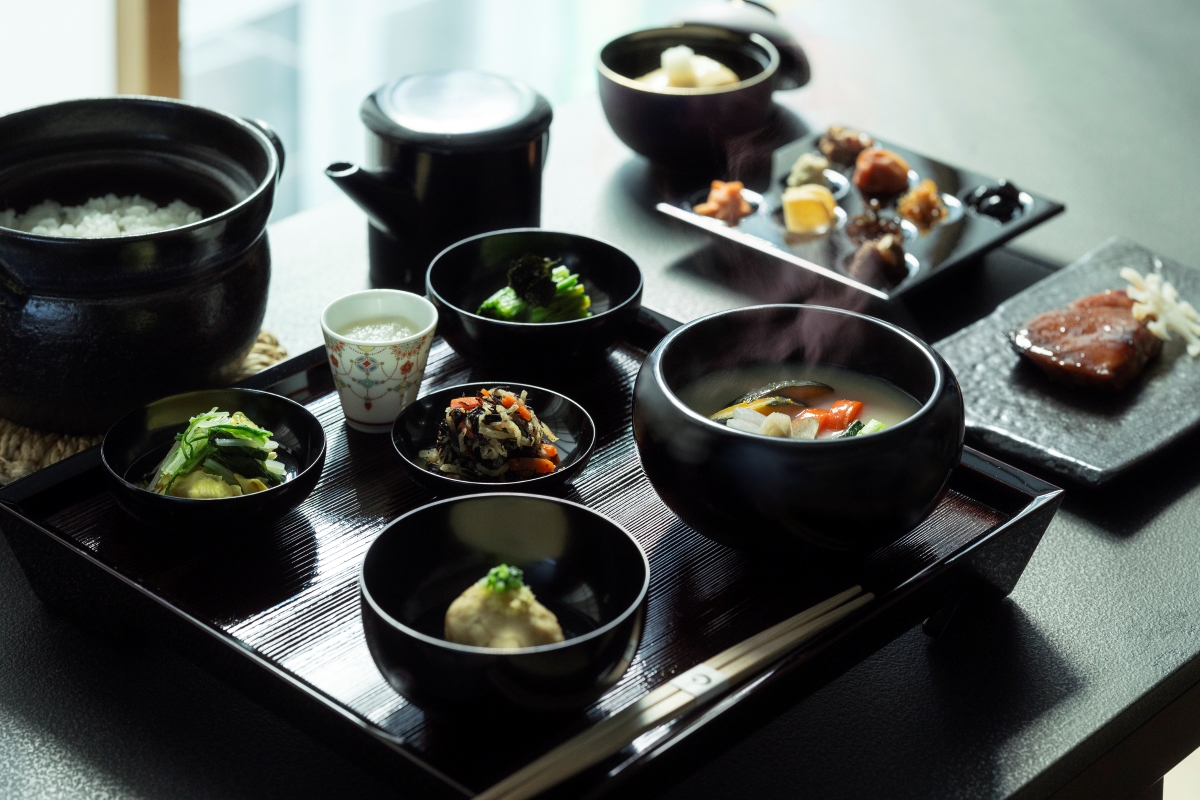
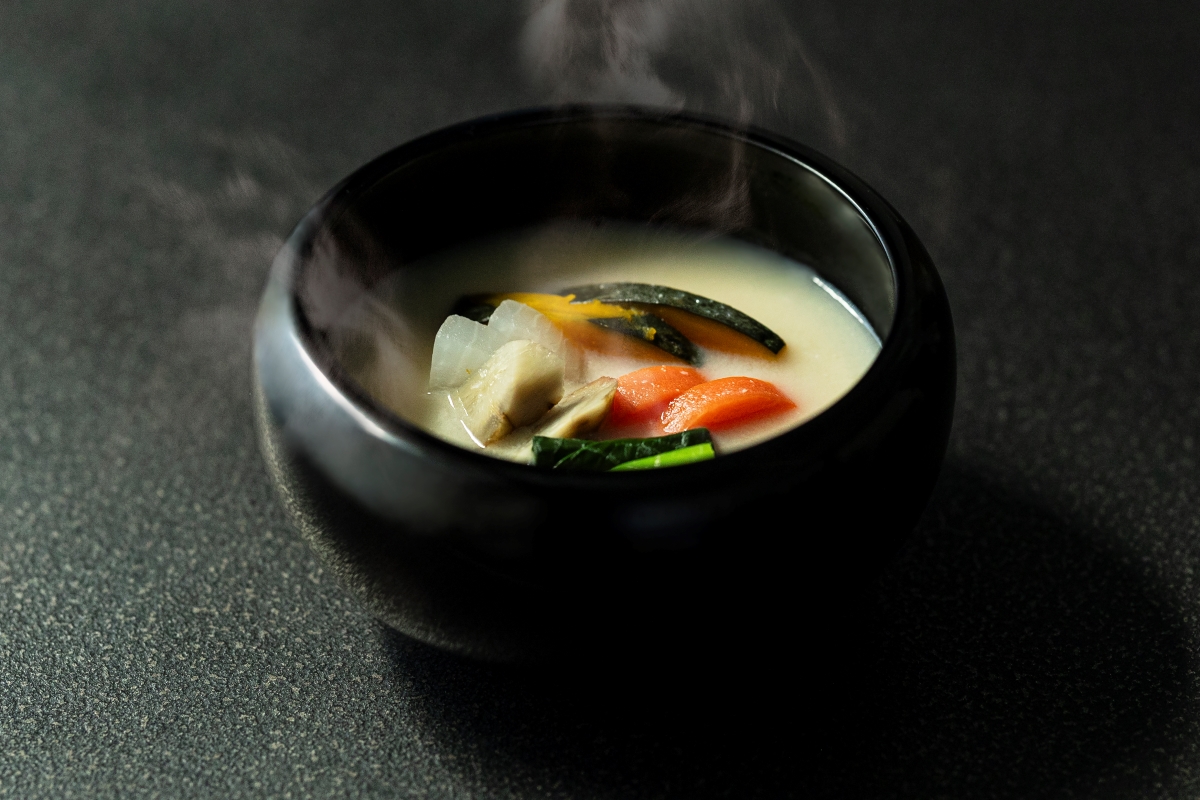
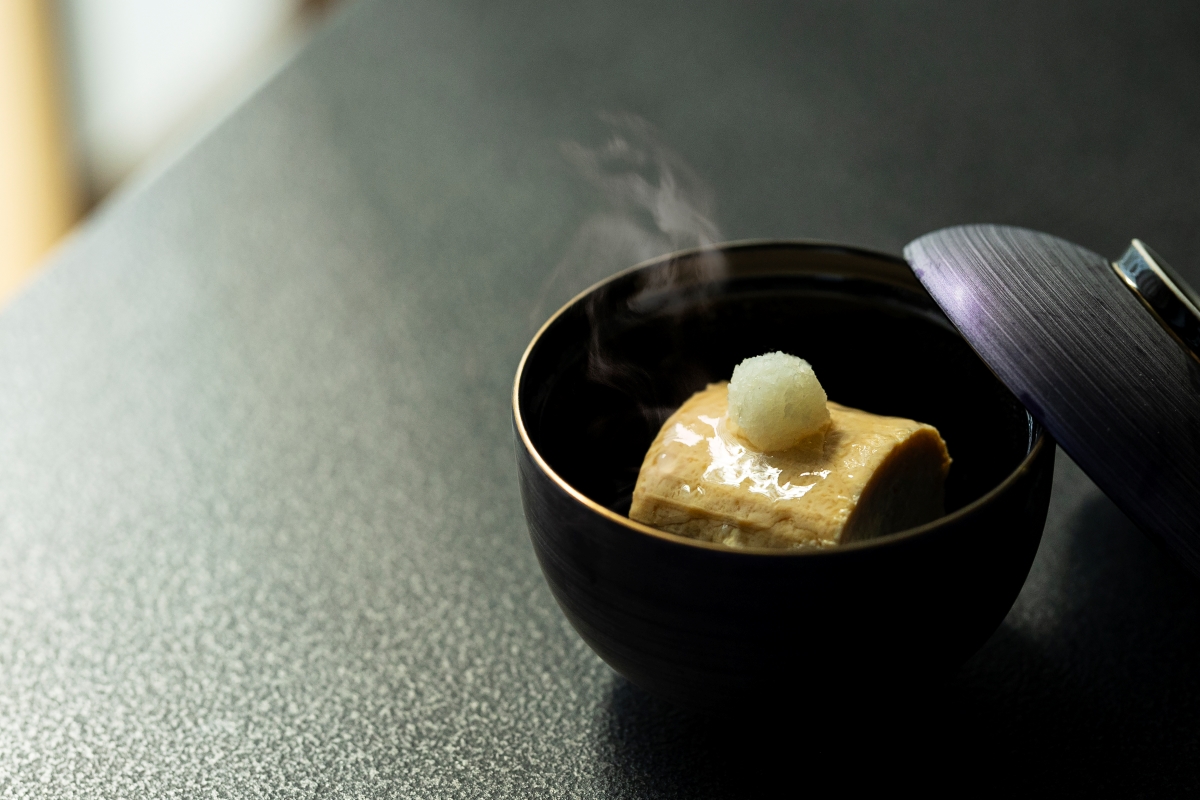
The Holistic Ryokan Breakfast is HOSHINOYA Tokyo's new Japanese-style breakfast, designed to balance the mind and body. The menu includes Kobachi (small side dishes), a Nine-item assortment, a Grilled dish, a Covered dish, Steamed white rice, and Miso soup.
Price: 9,680 JPY per person (tax and service charge included).
In-Room Breakfast: Japanese-Style
Freshly prepared breakfast is delivered in an original bamboo tiered box. This Japanese-style breakfast features grilled fish, freshly steamed rice, and a colorful, seasonal selection of four kobachi (small side dishes), salad, and dessert.
Price: 6,050 JPY per person(tax and service charge included)
In-Room Breakfast: Western-Style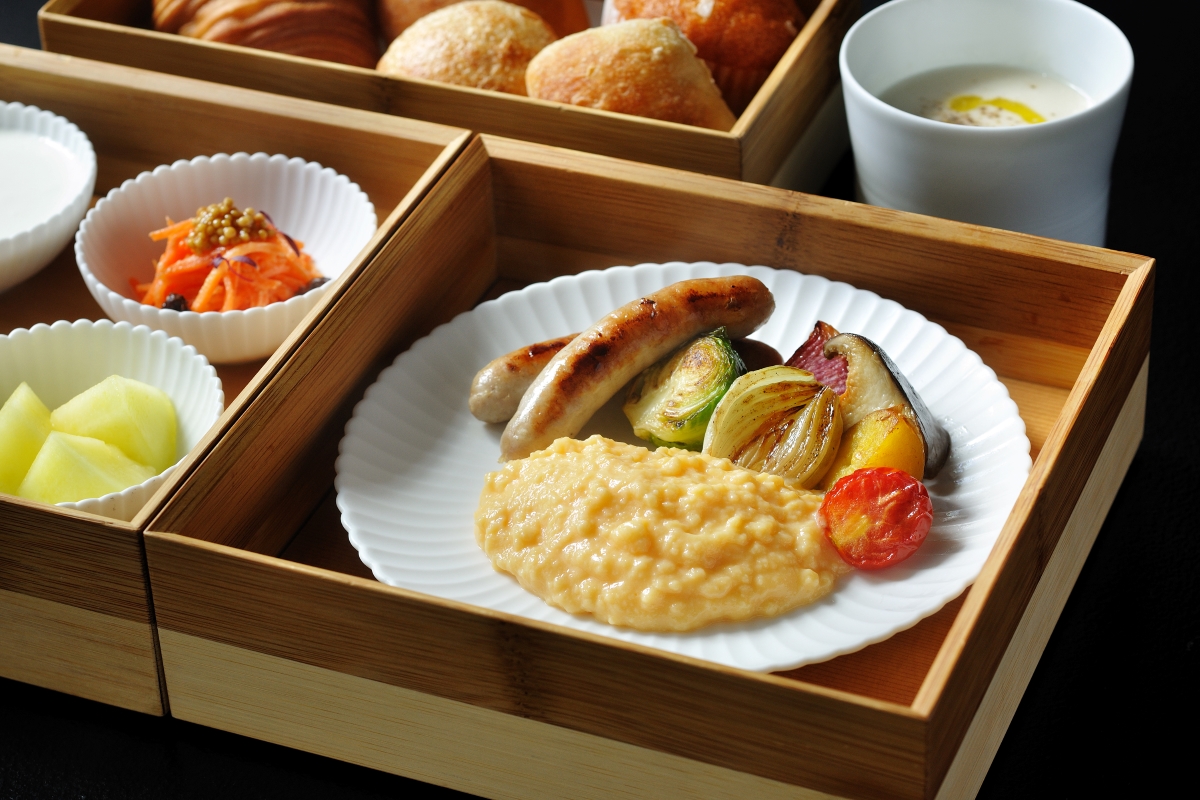
A Western-style breakfast featuring perfectly smooth scrambled eggs as the main item, served with seasonal soup, bread, and an appetizer made with seasonal ingredients, salad, and dessert.
Price: 6,050 JPY per person(tax and service charge included)
In-Room Dining
For guests who prefer to dine in their room, a time-limited menu, light meals, and drinks are available.
Dinner Exclusive Menu: Available from 5:00 pm – 9:00 pm (Last order at 8:00 pm)
Light Meal Menu: Available from 10:00 am – 9:00 pm (Last order at 8:00 pm)
*Includes options such as curry and donburi (rice bowls)
Experiencing the Culture of Edo and Tokyo through exclusive activities
Japanese Tea Ceremony
Deepen your understanding of the philosophy behind the Way of Tea. 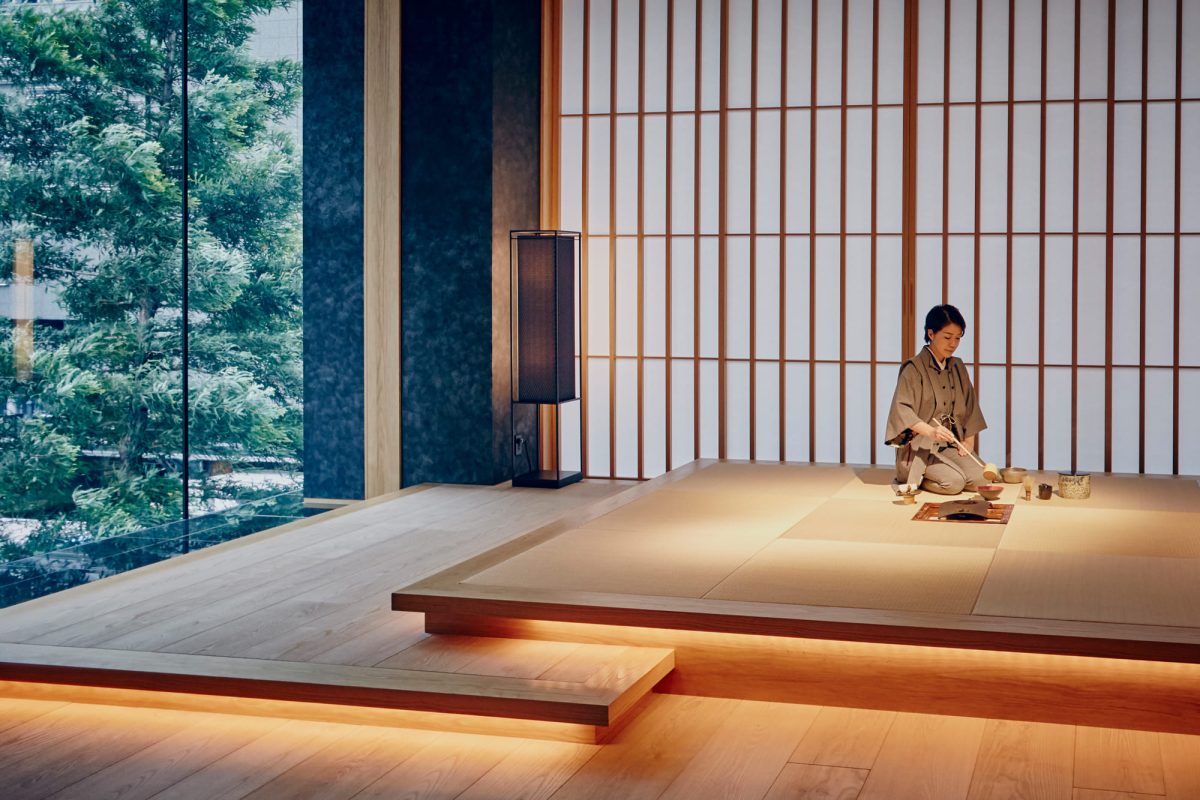 Offered Mon, Tue, Thu, Fri from 10:00 am – 10:30 am (2F Tatami Room)
Offered Mon, Tue, Thu, Fri from 10:00 am – 10:30 am (2F Tatami Room)
Price: 17,510 JPY per person (incl. tax/service).
The Art of Incense
Using a modern incense burner, guests "listen" to the scent to distinguish the subtle differences between three types of aromatic wood.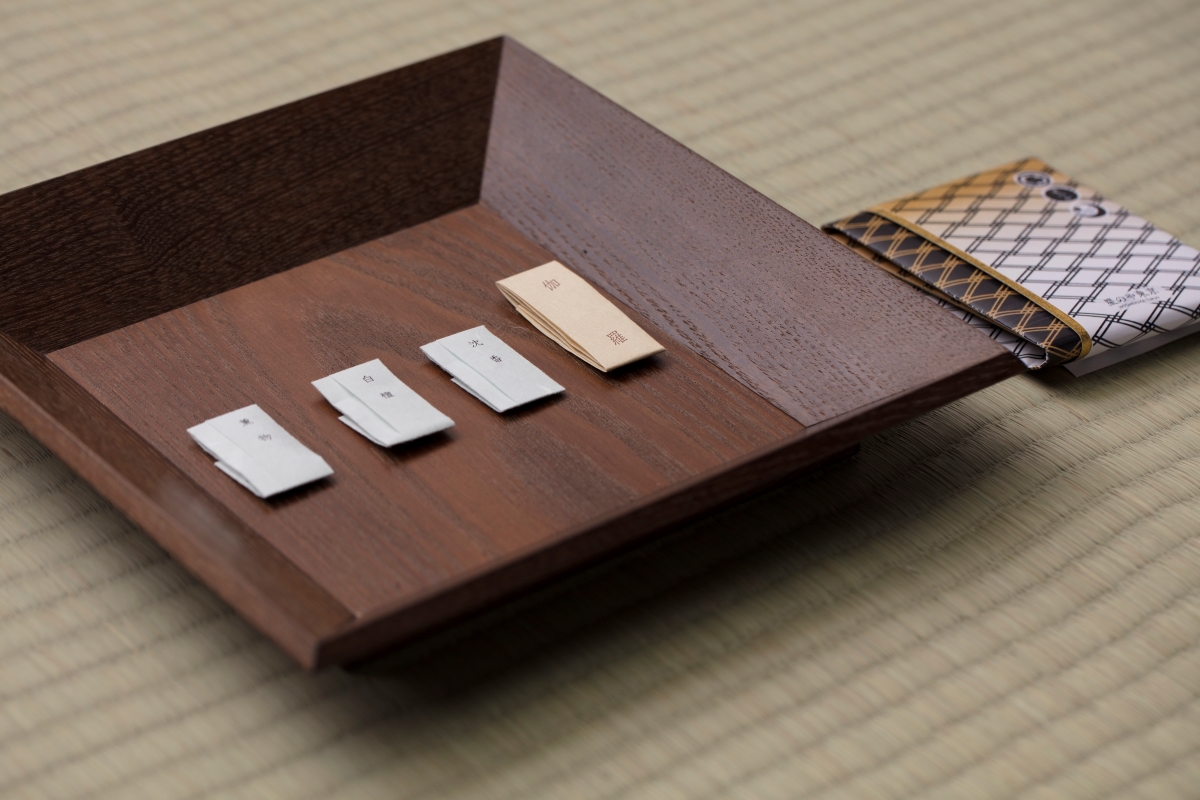
Offered Daily from 11:00 am – 11:30 am (2F Tatami Room)
Price: 2,662 JPY per person (incl. tax/service).
Sky-high Morning Kenjutsu Practice
An original practice combining kenjutsu movements with deep breathing, conducted on a building rooftop approx. 160 meters above ground, offering a superb view of the Tokyo skyline.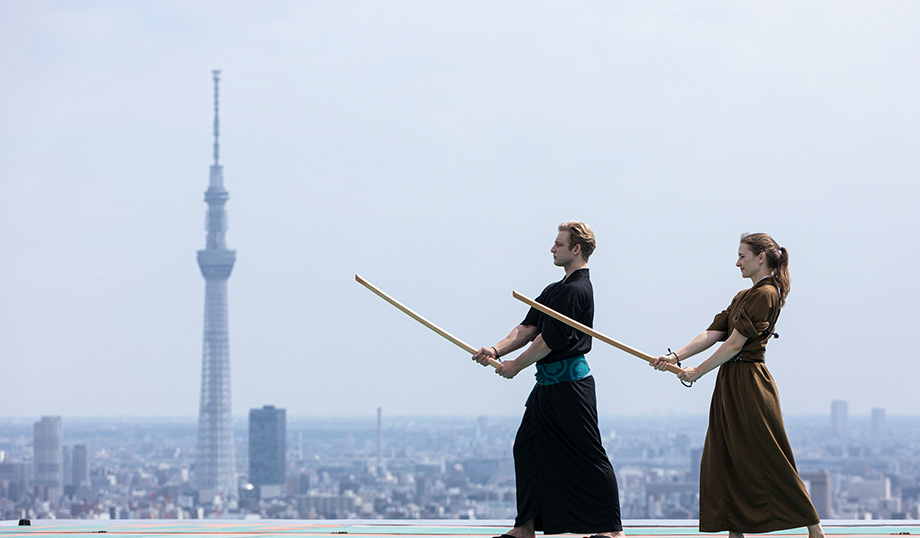
Offered Sun, Wed, Fri from 7:00 am – 8:00 am or 8:00 am – 9:00 am (Meet at 2F Reception)
Price: 5,500 JPY per person (incl. tax/service).
An Evening of Traditional Music
Young musicians perform Gagaku (ancient Japanese court music).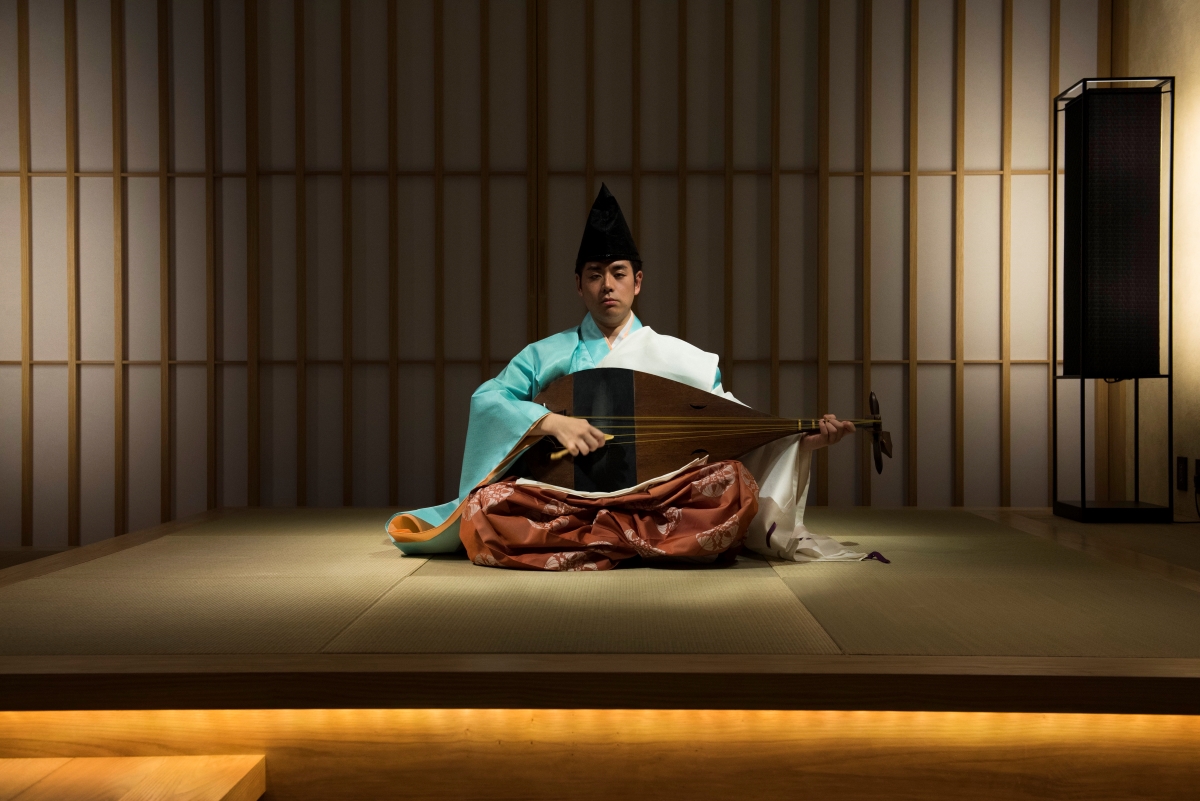
Offered Fri, Sat, Sun from 9:00 pm – 9:20 pm (2F Tatami Room)
Price: Free
Seasonal Miniature Garden Creation
Create an original moss garden inside a small paulownia wood box.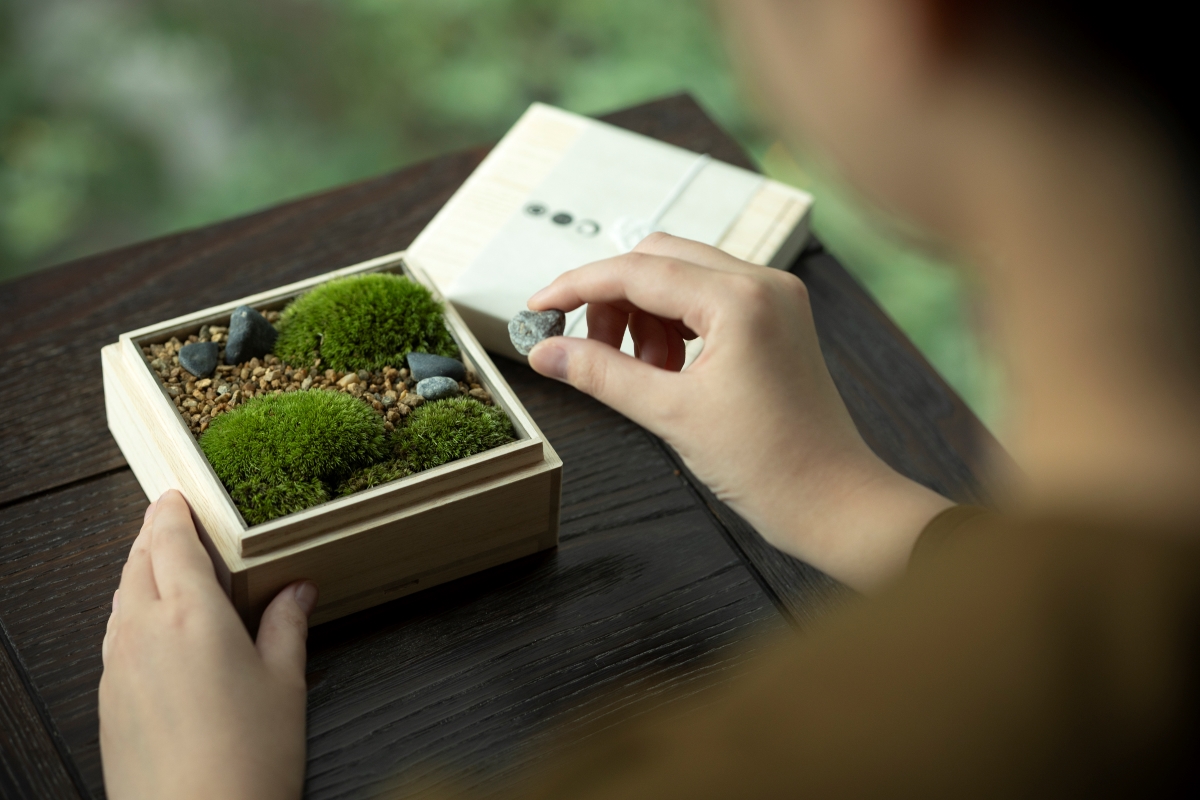
Offered Daily from 9:00 am – 9:30 am (2F Tatami Room)
Price: 5,000 JPY per person (incl. tax/service).
Tokyo River Cruise
Charter a boat from the Nihonbashi pier to view the cityscape of Tokyo from the river.
Available Year-round, chartered at a preferred time between 9:00 am and 10:00 pm
Price: 60,500 JPY per boat for 60 minutes (incl. tax/service).
Rickshaw Tour
Tour Edo-Tokyo on an original HOSHINOYA route starting from the entrance.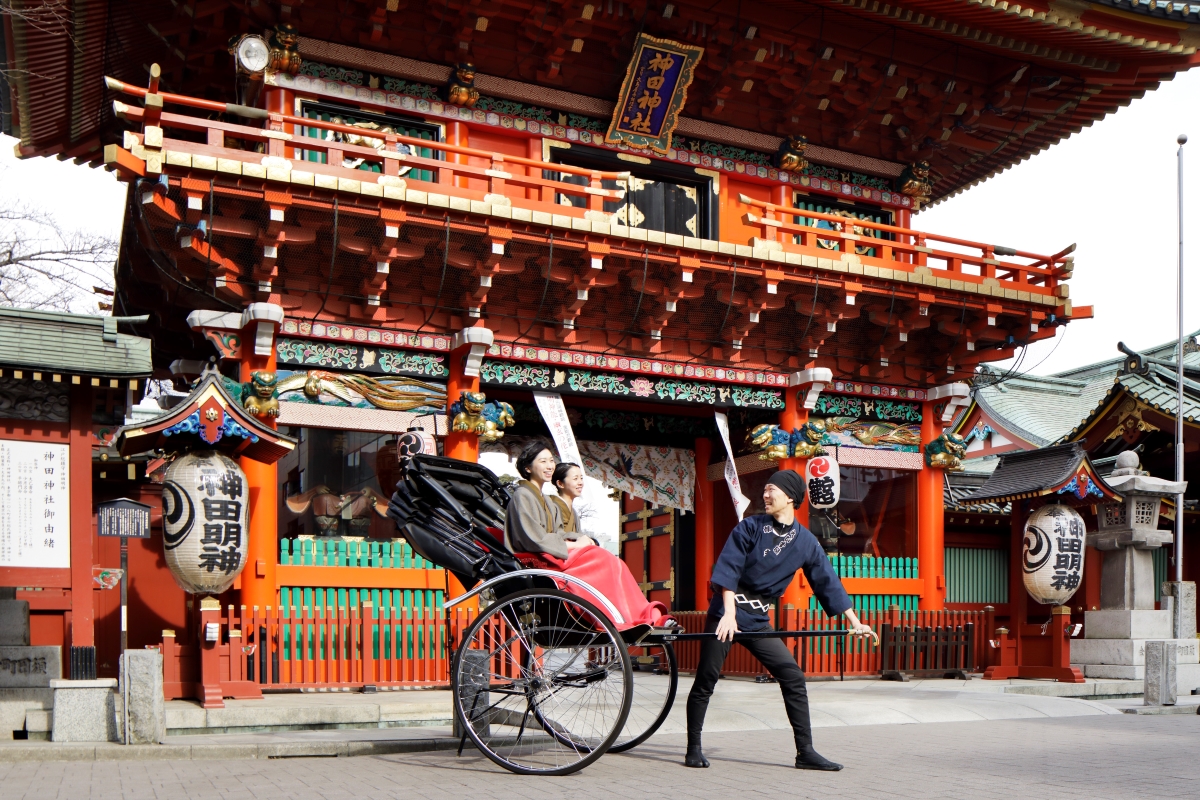
Available Year-round.
Price (incl. tax/service):
- Kanda/Ningyocho Course: 62,000 JPY per rickshaw for 90 minutes
- Nihonbashi Course: 53,000 JPY per rickshaw for 60 minutes
The Vision of Yoshiharu Hoshino, CEO of Hoshino Resorts
The Japanese ryokan is a rare type of accommodation that reflects local culture. However, in the process of Japan's modernization, it lost momentum and stopped evolving. Hoshino Resorts aims to evolve the ryokan once again. We position the ryokan as a distinct style of hotel and intend to transform it into an accommodation that can compete with Western-style hotels in functionality and convenience, in addition to its unique hospitality skills. Our goal is to create a market where people choose to "stay at a ryokan because it's comfortable and the service is excellent," rather than just "staying at a ryokan because they are in Japan." We will continue to pursue the dream of creating an era where the Japanese ryokan, with its ability to captivate the world, exists in major cities.
HOSHINOYA Tokyo Creation Team
Rie Azuma, Architect / Azuma Environmental Design and Architecture Institute
The key theme for this ambitious project was how to express what a ryokan in Tokyo should be, using the HOSHINOYA style. We considered the process of taking off shoes at the entrance and being guided to the room over the tatami mats to be an essential cultural experience. The guest rooms are designed to propose a new kind of relaxation on tatami while incorporating the comforts suited to modern life. The exterior design is inspired by the Edo Komon motif, which is subtle from a distance but vividly emerges upon approach. Overall, HOSHINOYA Tokyo is like a delicate o-jū (tiered lacquer box) gently placed within the office district.
Hiroki Hasegawa, Landscape Designer / Onsite Design Planning HOSHINOYA Tokyo, consisting of a single building in the city center, forms a completely public space as part of the urban plaza. The design foundation was how the presence of the ryokan could contribute to Tokyo's new urban landscape while creating an entrance appropriate for the HOSHINOYA space. The design introduces a garden-like world with a completely different sense of scale into an area dominated by skyscrapers, aiming for this world to simultaneously serve as a focal point in the urban landscape. We insisted on the craftsmanship quality for each small element, such as the four-band layered paving and the boat-like benches, creating the distinctive texture of a Japanese inn.
HOSHINOYA Tokyo, consisting of a single building in the city center, forms a completely public space as part of the urban plaza. The design foundation was how the presence of the ryokan could contribute to Tokyo's new urban landscape while creating an entrance appropriate for the HOSHINOYA space. The design introduces a garden-like world with a completely different sense of scale into an area dominated by skyscrapers, aiming for this world to simultaneously serve as a focal point in the urban landscape. We insisted on the craftsmanship quality for each small element, such as the four-band layered paving and the boat-like benches, creating the distinctive texture of a Japanese inn.
Ueyakato Landscape (Gardening/Paving)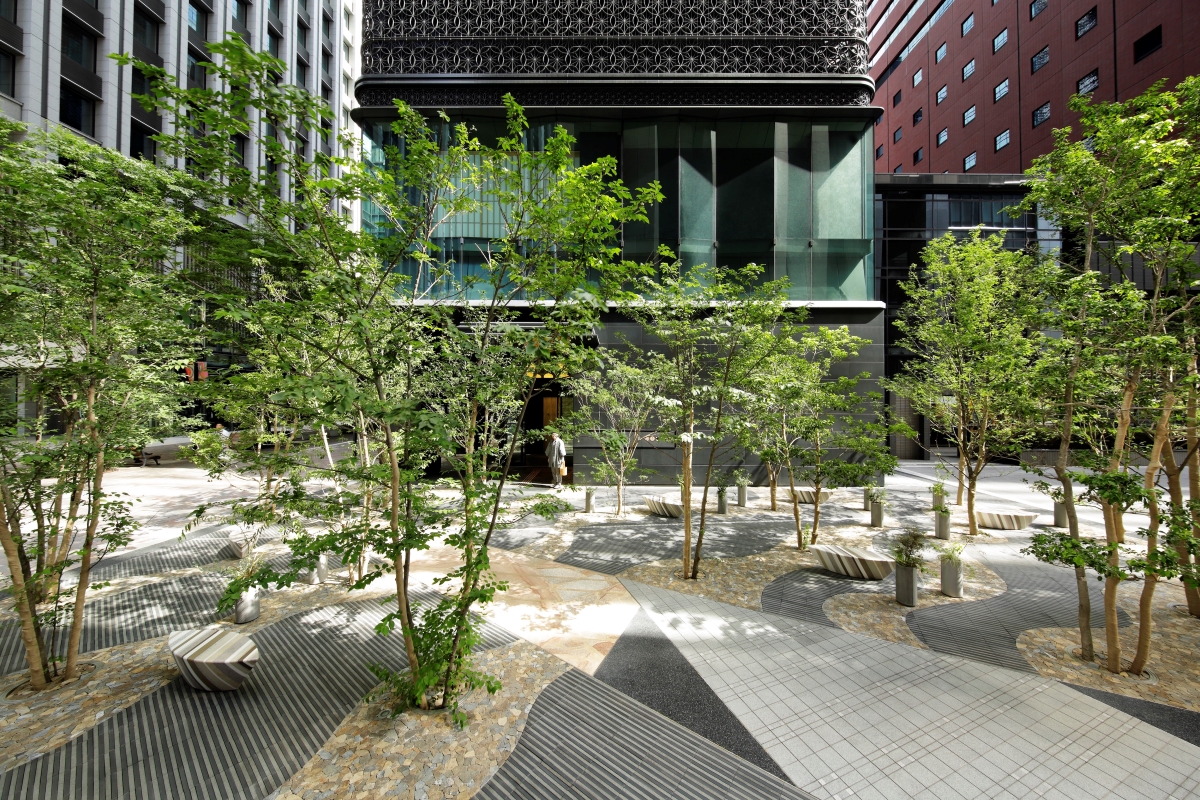 For the garden at HOSHINOYA Tokyo, Hiroki Hasegawa chose Ueyakato Landscape from Kyoto, a long-established company founded in 1848. Embracing their business philosophy of "Fueki Ryūkō" (the unchanging essence and the changing form), they successfully took on the challenge of creating a new form of Japanese garden for the modern era within an urban landscape.
For the garden at HOSHINOYA Tokyo, Hiroki Hasegawa chose Ueyakato Landscape from Kyoto, a long-established company founded in 1848. Embracing their business philosophy of "Fueki Ryūkō" (the unchanging essence and the changing form), they successfully took on the challenge of creating a new form of Japanese garden for the modern era within an urban landscape.
*The interior design and external design cooperation was led by Rie Azuma, Representative of Azuma Environmental Design and Architecture Institute, in collaboration with the HOSHINOYA design team, Mitsubishi Jisho Sekkei, and NTT FACILITIES. The environmental design was led by Hiroki Hasegawa, Representative of Onsite Design Planning, in collaboration with Mitsubishi Jisho Sekkei.
About HOSHINOYA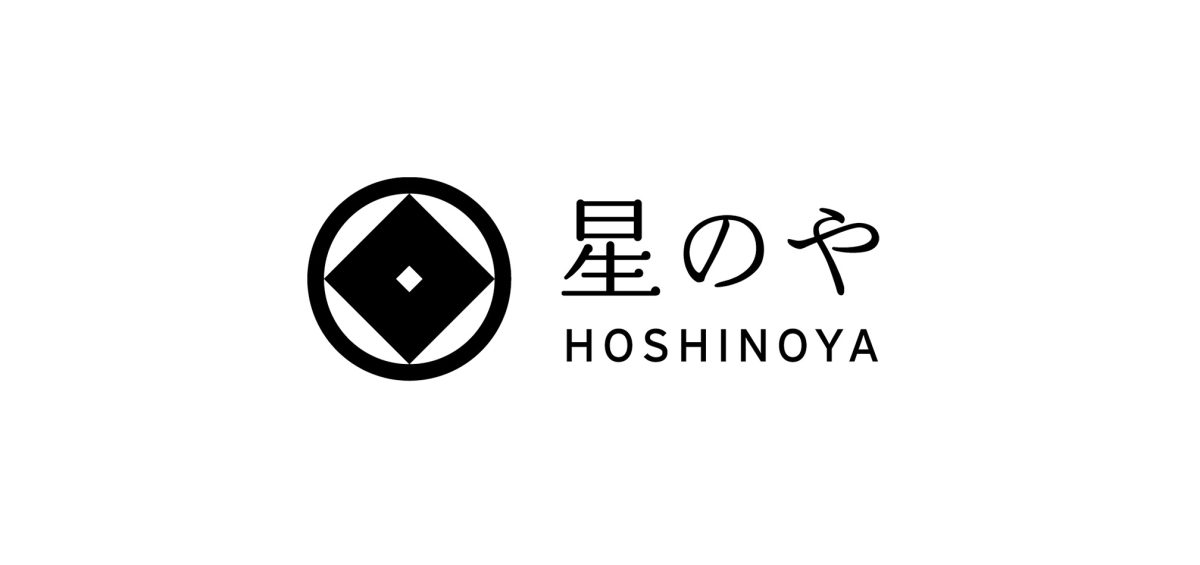 Luxury hotel embodying the true characteristics of land, history, and culture
Luxury hotel embodying the true characteristics of land, history, and culture
HOSHINOYA is an accommodation with distinct themes, conceptualized from each location's land, history, and culture. Woven into these distinct themes is our attention to detail in every aspect from the design to hospitality; contributing to the creation of a one-of-a-kind world of HOSHINOYA. Enrich the heart with the epiphanies of travel through a unique stay experience.